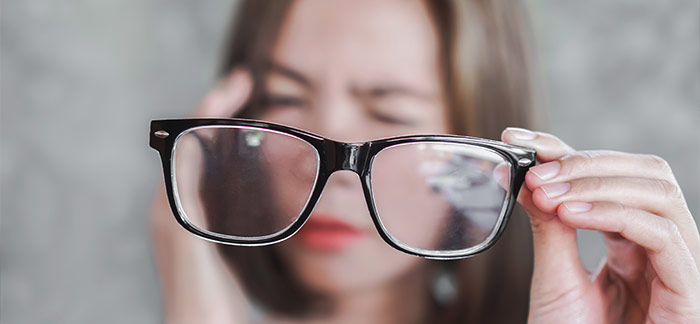|
Perhaps you’re diabetic and wondering whether you’re at risk for developing diabetic retinopathy. It is important to understand this condition and be more aware of what to keep an eye on so that you can better monitor your eyes’ wellness. The more informed you are, the better care you can take.
|
|
What’s diabetic retinopathy?
|
|
Diabetic retinopathy is a diabetes-related complication causing progressive damage to the light-sensitive tissue layer in your retina (back of the eye). This could either last for many years or be a lifelong ailment.
|
| How does it happen? |
|
If your blood contains too much sugar, this can, after a period, result in the blocking of your tiny blood vessels which sustain your retina. Ultimately, your blood supply is cut off. Your eye tries to compensate for this by growing new blood vessels. These can’t develop correctly, so they leak into your eye.
|
|
Who’s susceptible?
|
 |
|
While diabetic retinopathy is caused by diabetes mellitus (type 1 or 2) complications, it’s not guaranteed that all diabetics progress into diabetic retinopathy. However, poorly-controlled blood sugar, cholesterol and high blood pressure places you at risk.
If you mismanage your diabetes and don’t follow a strict diet, you’re vulnerable. The longer the duration of your diabetes, the higher your possibility of developing diabetic retinopathy will be.
Diabetic women could potentially develop diabetic retinopathy during pregnancy. Alternatively, if they already have it, the condition could deteriorate. Smoking tobacco could also increase your chances of developing diabetic retinopathy.
|
|
Do I have it?
|
 |
|
If you’re experiencing blurriness, blank or dark areas of vision, difficulty perceiving colours or floaters (noticeable spots or dark strings), these are all early signs of diabetic retinopathy. You could also have it without even knowing it, because the initial symptoms aren’t always evident.
Once the condition develops, these early indicators can worsen, normally at the same time in both eyes. You can suffer from fluctuating eyesight, further impaired colour vision, poor night vision, and even complete loss of central and peripheral vision altogether.
|
|
What can I do now?
|
|
If you’re concerned, consult an optometrist immediately for a medical diagnosis through a dilated eye exam. Thereafter, ensure you’re regularly screened to protect your eyesight. If treatment is required, you will be directed to an ophthalmologist. If you’re diabetic, you may then be referred to a diabetes specialist such as an endocrinologist to help you with a treatment plan.
Even if you are diabetic and aren’t initially diagnosed with diabetic retinopathy after your first screening, have a follow-up screening in a years’ time. Diabetics, in particular, require annual check-ups to monitor their eye health, because they’re the most susceptible to developing related complications.
|
|
How’s it treated?
|
|
If diabetic retinopathy is either undetected or left untreated, you can suffer from vision loss. This could eventually lead to blindness. While the condition can’t be cured, treatment can greatly help.
Once you’ve got your treatment plan, you’ll have a clearer idea of how to carry it out. There are various effective ways of slowing down the development of diabetic retinopathy. This plan could include:
- avoiding or limiting alcohol
- exercising often with a workout guide
- implementing a healthy diet
- quitting smoking
- having routine eye tests and screenings
- monitoring and managing your blood sugar levels and blood pressure often
- testing your cholesterol frequently
You’ll be advised regarding which foods you should and shouldn’t eat. An example diet includes healthy portions of dairy, fruit, meat, starch and vegetables. Ultimately, you’re aiming for food containing low-fat sugars and salts, and an eating plan that also helps you reach your ideal BMI.
If your blood sugar levels are correctly monitored, development in mild cases of diabetic retinopathy can be delayed. Careful and correct diabetes supervision with prescribed medicine can aid mild cases, or you may not even require any treatment.
Laser treatment or surgery is necessary in advanced cases. This is usually done either by an incision or injecting medicine into your eye. Laser treatment or surgery can preserve your vision as well as prevent additional vascular changes.
|
|
How often should I be screened?
|
|
Some guidelines regarding diabetic retinopathy screenings (through eye examinations):
- Type 1 diabetics: those older than 10 years of age should be screened within five years of their diabetes diagnosis
- Type 2 diabetics: have an initial screening upon your diabetes diagnosis (you might have unsuspectingly had diabetes for a while)
- Female diabetics: be screened before becoming pregnant or in your first trimester. Be monitored throughout your pregnancy up until a year of after giving birth.
The good news is that treatment can assist you. The sooner it’s detected, the quicker you can put an action plan into effect. Diabetic eye health is critical, so stayed informed about how diabetes can be monitored and treated to protect and prolong your vision. You still have a lot to look forward to in life!
|
|

